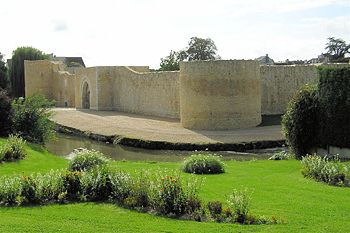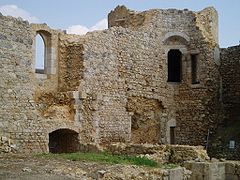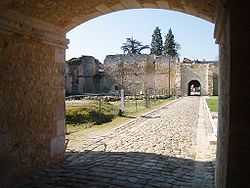
Château de Brie-Comte-Robert
Encyclopedia

Castle
A castle is a type of fortified structure built in Europe and the Middle East during the Middle Ages by European nobility. Scholars debate the scope of the word castle, but usually consider it to be the private fortified residence of a lord or noble...
in the town of Brie-Comte-Robert
Brie-Comte-Robert
Brie-Comte-Robert is a commune in the Seine-et-Marne department in the Île-de-France region in north-central France.Brie-Comte-Robert is on the edge of the plain of Brie and was formerly the capital of the Brie française....
in the Seine-et-Marne
Seine-et-Marne
Seine-et-Marne is a French department, named after the Seine and Marne rivers, and located in the Île-de-France region.- History:Seine-et-Marne is one of the original 83 departments, created on March 4, 1790 during the French Revolution in application of the law of December 22, 1789...
département of France.
12th - 13th centuries
The castle of Brie-Comte-Robert was built at the end of the 12th century, when Robert I of DreuxRobert I of Dreux
Robert I of Dreux, nicknamed the Great , was the fifth son of Louis VI of France and Adélaide de Maurienne. Through his mother he was related to the Carolingians and to the Marquess William V of Montferrat.In 1137 he received the County of Dreux as an appanage from his father...
, brother of the king Louis VII
Louis VII of France
Louis VII was King of France, the son and successor of Louis VI . He ruled from 1137 until his death. He was a member of the House of Capet. His reign was dominated by feudal struggles , and saw the beginning of the long rivalry between France and England...
, was lord of Brie
Brie
Brie is a historic region of France most famous for its dairy products, especially Brie cheese. It was once divided into two sections ruled by different feudal lords: the western Brie française, corresponding roughly to the modern department of Seine-et-Marne in the Île-de-France region; the...
. Archaeological clues, elements of decoration and the choice of construction techniques, suggest the architecture of this turning point in history.
14th century
The castle remained in the Dreux family until 1254, then passed to the family of Châtillon. Through successive dowries and inheritances, it came to Marguerite d'ArtoisMahaut, Countess of Artois
Mahaut of Artois , also known as Mathilda, was the only daughter, and eldest child of Robert II, Count of Artois and Amicie de Courtenay.- Lineage :...
and then her daughter, Jeanne d'Évreux
Jeanne d'Evreux
Jeanne d'Évreux was the third wife of King Charles IV of France, daughter of his uncle Louis d'Évreux and Margaret of Artois. She bore no male heir, thus "causing" the end of the direct line of the Capetian dynasty. Because she was his first cousin, the couple required papal permission to marry...
.

House of Capet
The House of Capet, or The Direct Capetian Dynasty, , also called The House of France , or simply the Capets, which ruled the Kingdom of France from 987 to 1328, was the most senior line of the Capetian dynasty – itself a derivative dynasty from the Robertians. As rulers of France, the dynasty...
king, Charles IV the Fair
Charles IV of France
Charles IV, known as the Fair , was the King of France and of Navarre and Count of Champagne from 1322 to his death: he was the last French king of the senior Capetian lineage....
. After his death in 1328, she profited from comfortable revenues (a royal dower
Dower
Dower or morning gift was a provision accorded by law to a wife for her support in the event that she should survive her husband...
of many fiefdoms in Brie
Brie
Brie is a historic region of France most famous for its dairy products, especially Brie cheese. It was once divided into two sections ruled by different feudal lords: the western Brie française, corresponding roughly to the modern department of Seine-et-Marne in the Île-de-France region; the...
and Champagne
Champagne (province)
The Champagne wine region is a historic province within the Champagne administrative province in the northeast of France. The area is best known for the production of the sparkling white wine that bears the region's name...
), which enabled her to devote important sums to the maintenance and the improvement of her own possessions, including Brie-Comte-Robert. She did important work to the castle, as her accounts preserved at the Archives Nationales (national archives) attest.
The castle became a prestigious residence which the large lords of the kingdom, in particular the dukes of Burgundy
Duke of Burgundy
Duke of Burgundy was a title borne by the rulers of the Duchy of Burgundy, a small portion of traditional lands of Burgundians west of river Saône which in 843 was allotted to Charles the Bald's kingdom of West Franks...
, did not hesitate to visit. It was also the site, in 1349, of the marriage of Philip VI
Philip VI of France
Philip VI , known as the Fortunate and of Valois, was the King of France from 1328 to his death. He was also Count of Anjou, Maine, and Valois from 1325 to 1328...
of Valois and Blanche d'Évreux
Blanche d'Evreux
Blanche of Navarre was Queen consort of France as the wife of King Philip VI of France.She was the second child and daughter of Queen Joan II of Navarre and King Philip III of Navarre...
, niece of queen Jeanne.
The lady of Brie made the siegneurial residence luxurious, particularly in the area located against the south-western and south-eastern curtains and, above all, in the north-east. She had a chapel built dedicated to Saint-Denis
Denis
Saint Denis is a Christian martyr and saint. In the third century, he was Bishop of Paris. He was martyred in connection with the Decian persecution of Christians, shortly after A.D. 250...
, joined to the Tour Saint-Jean (St John Tower), and laid out vast pleasure gardens. Jeanne d'Évreux died in the castle in 1371, aged 69.
At the end of the 14th century, the castle returned into the royal domain
Crown lands of France
The crown lands, crown estate, royal domain or domaine royal of France refers to the lands, fiefs and rights directly possessed by the kings of France...
, then later to the Orléans family.
15th century
Louis I de Valois, Duke of Orléans led a sparkling life at the castle of Brie-Count-Robert (tournamentsTournament (medieval)
A tournament, or tourney is the name popularly given to chivalrous competitions or mock fights of the Middle Ages and Renaissance . It is one of various types of hastiludes....
, receptions of great nobles), but, faced with growing insecurity, he strengthened the castle from 1405. Following his assassination by John the Fearless, duke of Burgundy, and the founding of the Armagnac Party
Armagnac (party)
The Armagnac party was prominent in French politics and warfare during the Hundred Years' War. It was allied with the supporters of Charles, Duke of Orléans against John the Fearless after Charles' father Louis of Orléans was killed at the orders of the Duke of Burgundy in 1407...
in 1407, the castle passed under the control of the Burgundian Party
Burgundian (party)
The Burgundian party was a political allegiance in France that formed during the reign of Charles VI during the latter half of the Hundred Years' War...
, thus securing it as a safe stage on the road from Paris towards Burgundy.
In 1420, the passage of the English army, en route to Troyes
Troyes
Troyes is a commune and the capital of the Aube department in north-central France. It is located on the Seine river about southeast of Paris. Many half-timbered houses survive in the old town...
, and the siege of Melun
Melun
Melun is a commune in the Seine-et-Marne department in the Île-de-France region in north-central France. Located in the south-eastern suburbs of Paris, Melun is the capital of the department, as the seat of an arrondissement...
which followed, brought some disorder to the town, but did not affect the castle. It is from 1429 that the city was, « par quatre diverses fois en trois ans », ("four separate times in three years"), taken and retaken by the French and the English. The major event remains however the siege begun in September 1430 by the Humphrey Stafford, 1st Duke of Buckingham
Humphrey Stafford, 1st Duke of Buckingham
Humphrey Stafford, 1st Duke of Buckingham KG , an English nobleman, great grandson of King Edward III on his mother's side, was best known as a military commander in the Hundred Years' War and in the Wars of the Roses....
, who caused immense damage, in the town as well as to the castle. The place was repurchased by the French in 1434 and was returned to its rightful owner, Charles of Orléans. His son, the future king Louis XII
Louis XII of France
Louis proved to be a popular king. At the end of his reign the crown deficit was no greater than it had been when he succeeded Charles VIII in 1498, despite several expensive military campaigns in Italy. His fiscal reforms of 1504 and 1508 tightened and improved procedures for the collection of taxes...
, placed the castle in the royal domain.
16th century
Starting from the reign of Francis IFrancis I of France
Francis I was King of France from 1515 until his death. During his reign, huge cultural changes took place in France and he has been called France's original Renaissance monarch...
, the castle and its grounds were entrusted by the king to some of his close associates, either by way of favour (« don pour un temps » - "gift for a time"), or by conditional sale with option of repurchase (« l'engagement »). Among them were, notably: Louis Poncher, Philippe de Chabot
Philippe de Chabot
Philippe de Chabot, Seigneur De Brion, Count of Charny and Buzançois , also known as Admiral De Brion, was an admiral of France.- Biography :...
, the marshal Jean Caraccioli, Balthazar Goblin and Claude de Bullion, superintendent of the finances of Louis XIII
Louis XIII of France
Louis XIII was a Bourbon monarch who ruled as King of France and of Navarre from 1610 to 1643.Louis was only eight years old when he succeeded his father. His mother, Marie de Medici, acted as regent during Louis' minority...
.
In the middle of the century, various families of Italian lords, close to Catherine de' Medici
Catherine de' Medici
Catherine de' Medici was an Italian noblewoman who was Queen consort of France from 1547 until 1559, as the wife of King Henry II of France....
(Aquaviva, Pierrevive, Gondi), held the castle, but allowed the building to deteriorate, even causing the burning of the floors and some frames.
A 1567 law passed by the Parliament was needed to put an end to this damage. At the end of the century, Balthazar Goblin, follower of Henri IV
Henry IV of France
Henry IV , Henri-Quatre, was King of France from 1589 to 1610 and King of Navarre from 1572 to 1610. He was the first monarch of the Bourbon branch of the Capetian dynasty in France....
, made repairs to the castle.
The castle was still in a position to receive the young Louis XIII twice, in 1609 and 1611.
17th century
In 1649, at the time of the FrondeFronde
The Fronde was a civil war in France, occurring in the midst of the Franco-Spanish War, which had begun in 1635. The word fronde means sling, which Parisian mobs used to smash the windows of supporters of Cardinal Mazarin....
disorders, the town and the castle of Brie-Comte-Robert, were taken by the royal troops commanded by the count de Grancey. The castle was cannonaded by a battery for more than five hours, losing its south-eastern tower.
Later repairs had to be very modest: in 1681, the castle was regarded as "... uninhabitable, the ditches full of rubbish, the garden fallow..." (« inhabitable, les fossés comblés d'immondices, le jardin en friche... »).
Jean-Antoine de Mesmes, first President of the parlement
Parlement
Parlements were regional legislative bodies in Ancien Régime France.The political institutions of the Parlement in Ancien Régime France developed out of the previous council of the king, the Conseil du roi or curia regis, and consequently had ancient and customary rights of consultation and...
of Paris carried out various maintenance works on the roofs and repairs to the access bridges. Legal documents from this period describe some internal developments. The castle was then inhabited by private individuals.
18th century
In 1750, Germain-Louis de Chauvelin, lord since 1734, asserting the dilapidation of the building, obtained authorisation to reduce the towers and the curtains to the level of the first floor, excepting however the Saint-Jean tower, the manorial symbol.Repurchased by the king Louis XV
Louis XV of France
Louis XV was a Bourbon monarch who ruled as King of France and of Navarre from 1 September 1715 until his death. He succeeded his great-grandfather at the age of five, his first cousin Philippe II, Duke of Orléans, served as Regent of the kingdom until Louis's majority in 1723...
in 1766, the manor of Brie-Count-Robert, including the castle, was the subject of an exchange between Louis and his cousin, Louis Charles de Bourbon, Count of Eu. His heirs, the duke of Penthièvre
Louis Jean Marie de Bourbon, duc de Penthièvre
Louis Jean Marie de Bourbon was the son of Louis Alexandre de Bourbon and his wife Marie Victoire de Noailles. He was also a grandson of Louis XIV of France and his mistress, Madame de Montespan. From birth he was known as the Duke of Penthièvre...
, and then his daughter, the duchess of Orléans, were the last lords.
During the French Revolution
French Revolution
The French Revolution , sometimes distinguished as the 'Great French Revolution' , was a period of radical social and political upheaval in France and Europe. The absolute monarchy that had ruled France for centuries collapsed in three years...
, the building was used to imprison the baron de Besenval, colonel of the Swiss Guard
Swiss Guard
Swiss Guards or Schweizergarde is the name given to the Swiss soldiers who have served as bodyguards, ceremonial guards, and palace guards at foreign European courts since the late 15th century. They have had a high reputation for discipline, as well as loyalty to their employers...
s and military commander of the Île-de-France
Île-de-France (province)
The province of Île-de-France or Isle de France is an historical province of France, and the one at the centre of power during most of French history...
. The building was later sold as national property.
19th and 20th centuries

Massive topsoil deposits transformed the court and the jousting yard into a vast vegetable garden. The commune repurchased the castle in 1923 and it was classified as a monument historique
Monument historique
A monument historique is a National Heritage Site of France. It also refers to a state procedure in France by which national heritage protection is extended to a building or a specific part of a building, a collection of buildings, or gardens, bridges, and other structures, because of their...
in 1925.
From 1982, the municipality undertook a programme to repair the site, including archaeological works. These have guided the later restoration programme of the castle's remains.
Today
2003 saw the beginning of a grand programme of restoration of the castle, with the rebuilding of curtains to a height more than six metres, the restoration of the Tour de Brie, and the demolition of the 19th century house in the courtyard, allowing the partial rebuilding of the Tour Saint-Jean, according to archaeological documents.Inside the enclosure, the construction of a modern building, the Centre d'Interprétation du Patrimoine (Heritage Interpretation Centre), allows the Association des Amis du Vieux Château (Friends of the Old Château Association) to design and present a permanent exhibition of the site and to undertake teaching activities.

